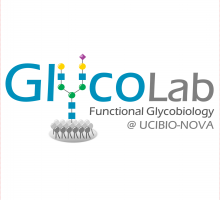Molecular basis for the preferential recognition of beta 1,3-1,4-glucans by the family 11 carbohydrate-binding module from Clostridium thermocellum.
- Citation:
- Ribeiro, Diana O., Aldino Viegas, Virgínia M. R. Pires, João Medeiros-Silva, Pedro Bule, Wengang Chai, Filipa Marcelo, Carlos M. G. A. Fontes, Eurico J. Cabrita, Angelina S. Palma, and Ana Luísa Carvalho. "Molecular basis for the preferential recognition of beta 1,3-1,4-glucans by the family 11 carbohydrate-binding module from Clostridium thermocellum." The FEBS journal. 287 (2020): 2723-2743.
Abstract:
Understanding the specific molecular interactions between proteins and $\beta$1,3-1,4-mixed-linked d-glucans is fundamental to harvest the full biological and biotechnological potential of these carbohydrates and of proteins that specifically recognize them. The family 11 carbohydrate-binding module from Clostridium thermocellum (CtCBM11) is known for its binding preference for $\beta$1,3-1,4-mixed-linked over $\beta$1,4-linked glucans. Despite the growing industrial interest of this protein for the biotransformation of lignocellulosic biomass, the molecular determinants of its ligand specificity are not well defined. In this report, a combined approach of methodologies was used to unravel, at a molecular level, the ligand recognition of CtCBM11. The analysis of the interaction by carbohydrate microarrays and NMR and the crystal structures of CtCBM11 bound to $\beta$1,3-1,4-linked glucose oligosaccharides showed that both the chain length and the position of the $\beta$1,3-linkage are important for recognition, and identified the tetrasaccharide Glc$\beta$1,4Glc$\beta$1,4Glc$\beta$1,3Glc sequence as a minimum epitope required for binding. The structural data, along with site-directed mutagenesis and ITC studies, demonstrated the specificity of CtCBM11 for the twisted conformation of $\beta$1,3-1,4-mixed-linked glucans. This is mediated by a conformation-selection mechanism of the ligand in the binding cleft through CH-$π$ stacking and a hydrogen bonding network, which is dependent not only on ligand chain length, but also on the presence of a $\beta$1,3-linkage at the reducing end and at specific positions along the $\beta$1,4-linked glucan chain. The understanding of the detailed mechanism by which CtCBM11 can distinguish between linear and mixed-linked $\beta$-glucans strengthens its exploitation for the design of new biomolecules with improved capabilities and applications in health and agriculture. DATABASE: Structural data are available in the Protein Data Bank under the accession codes 6R3M and 6R31.
Notes:
n/a
